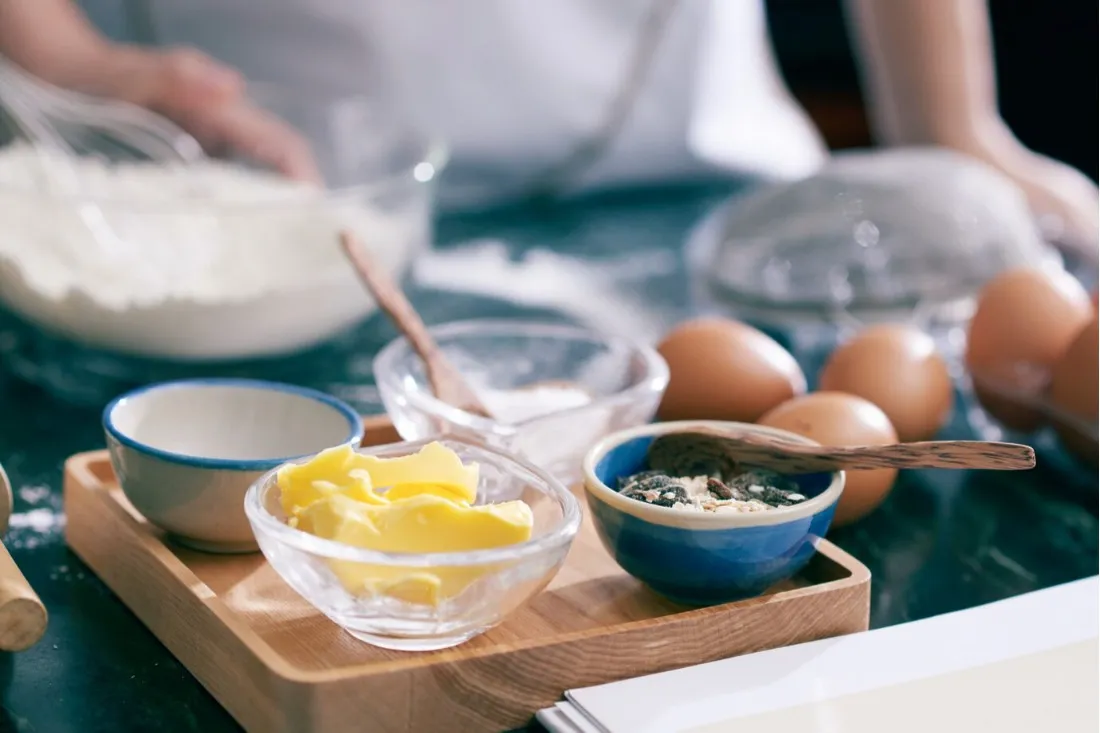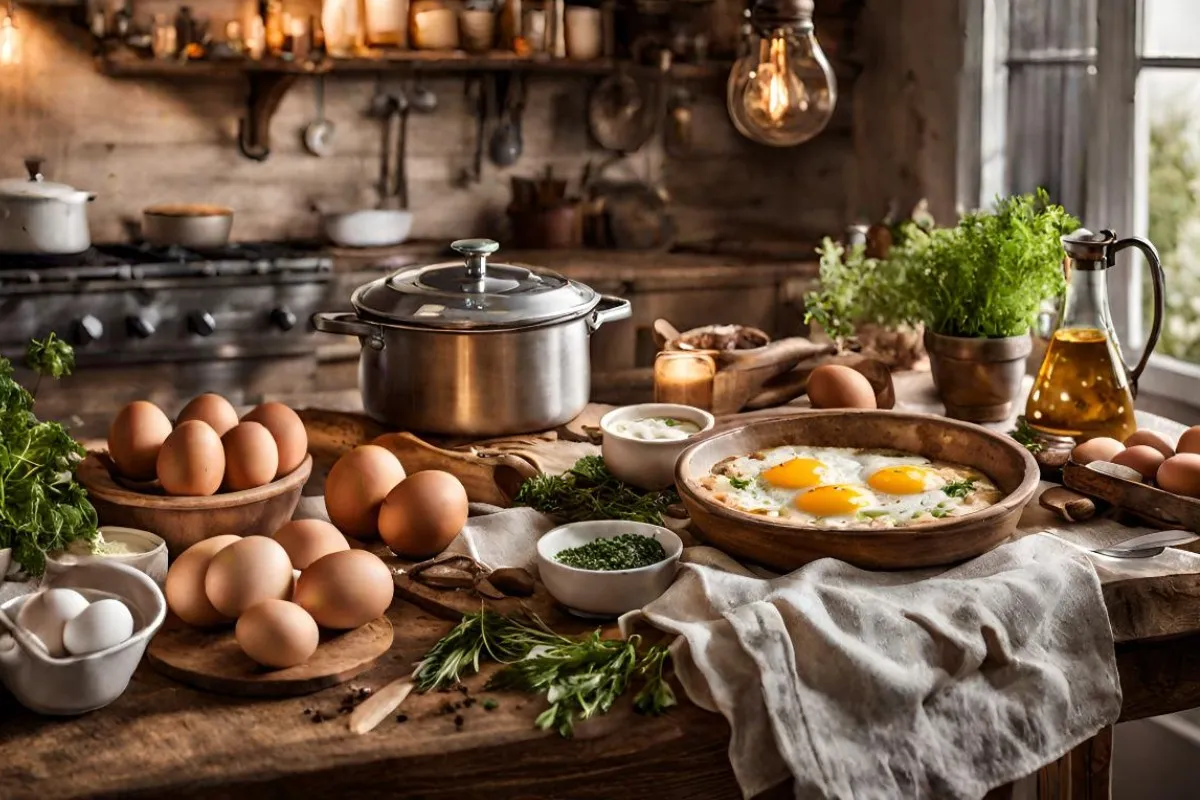Embarking on a culinary journey, this article delves into the delightful world of Eggs en Cocotte, a classic yet often overlooked gem in French cuisine. But what is the meaning of eggs en cocotte? From its rich history to the nuances of preparation, we’ll explore every facet of this elegant dish. Whether you’re a seasoned chef or a curious foodie, this comprehensive guide promises to enrich your cooking repertoire and tantalize your taste buds. So, let’s crack open the secrets of Eggs en Cocotte and discover what makes this dish a timeless treasure in the culinary world.
Introduction to Eggs en Cocotte
Eggs en Cocotte stands as a testament to the elegance and simplicity of French cuisine. Often overlooked, this dish deserves recognition for its understated charm and versatility. But what is the meaning of eggs en cocotte? Let’s explore.
Introduction to the Dish
Eggs en Cocotte may sound complex, but it’s simply eggs baked in small ramekins or cocottes. Its roots lie in the cozy kitchens of France, starting as a simple breakfast item. Over time, it has evolved into a sophisticated dish found in high-end restaurants and gourmet cookbooks. Understanding what is the meaning of eggs en cocotte is key to appreciating its culinary value.
The dish’s beauty lies in its simplicity and the endless possibilities for customization. It’s a canvas for creativity, allowing chefs and home cooks to experiment with various ingredients. Despite its simplicity, the dish exudes sophistication, making it perfect for an elegant brunch or special morning treat. This brings us to the question: what is the meaning of eggs en cocotte in the context of modern cuisine?
In the following sections, we’ll explore Eggs en Cocotte. From understanding its essence to mastering its preparation, this guide will equip you with the knowledge to bring this delightful dish to your table. Let’s begin our journey into the heart of French cuisine and uncover the secrets of making the perfect Eggs en Cocotte.
Understanding Eggs en Cocotte

We now delve deeper into Eggs en Cocotte, uncovering the essence and cultural significance of this delightful dish. This part of our journey enlightens us about what Eggs en Cocotte truly are and their place in the rich tapestry of French cuisine, answering the question: what is the meaning of eggs en cocotte?
Definition and Meaning
Eggs en Cocotte involves gently baking eggs in individual ramekins or small cocottes, often with various flavorings like cheese, herbs, and cream. The term ‘en cocotte’ translates to ‘in a casserole’ in French, referring here to the unique method of baking eggs in individual vessels. This technique allows for even cooking and a delicate texture, with runny yolks and just-set whites, creating a creamy and savory balance. So, what is the meaning of eggs en cocotte in culinary terms? It’s a testament to the art of gentle cooking and flavor harmony.
Unlike scrambled or poached eggs, Eggs en Cocotte offer a unique texture and presentation. They stand out due to their individual serving style and potential for intricate flavor layering. This dish exemplifies how simple ingredients, combined with the right technique, can create something extraordinary. Understanding what is the meaning of eggs en cocotte is essential for appreciating its culinary uniqueness.
Cultural Significance
In French cuisine, Eggs en Cocotte symbolize the country’s culinary finesse. The dish reflects the French philosophy of using simple, high-quality ingredients to create visually appealing and delicious meals. It’s a dish that tells a story of tradition, yet adapts beautifully to contemporary tastes. What is the meaning of eggs en cocotte in the context of French culture? It’s a symbol of culinary elegance and simplicity.
In France’s various regions, you’ll find different interpretations of Eggs en Cocotte, each adding a local twist. Whether it’s a regional cheese or a locally sourced herb, these variations add diversity and speak of France’s rich culinary heritage. This brings us back to the central question: what is the meaning of eggs en cocotte in the diverse landscape of French cuisine?
Eggs en Cocotte may not be as globally renowned as other French dishes, but they hold a special place in the hearts of those who appreciate French cooking. As we move forward, we’ll learn how to bring this quintessentially French experience to your kitchen, exploring the ingredients and steps involved in creating this exquisite dish.
Preparing Eggs en Cocotte

Now, we roll up our sleeves and dive into the heart of the matter: preparing Eggs en Cocotte. This part of our journey is all about transforming simple ingredients into a dish that’s both comforting and elegant. Let’s walk through the essentials of ingredients and the step-by-step process to ensure your culinary creation is a success.
Ingredients and Equipment
To start, you’ll need a few basic ingredients: fresh eggs, cream, butter, and your choice of flavorings like cheese, herbs, or ham. The beauty of Eggs en Cocotte lies in its versatility, so feel free to get creative with the additions. High-quality, fresh ingredients are key to elevating the dish’s flavors.
As for equipment, the most crucial item is the cocotte or ramekin. These small, oven-proof dishes are perfect for individual servings and provide the ideal environment for the eggs to cook evenly. You’ll also need a baking tray and some boiling water for the bain-marie (water bath) method, which ensures gentle cooking.
Step-by-Step Cooking Process
- Preheat the Oven: Start by preheating your oven to a moderate temperature. This ensures a gentle cooking process, keeping the eggs tender.
- Prepare the Ramekins: Grease the ramekins with butter to prevent sticking. You can layer the bottom with your chosen ingredients – perhaps some sautéed spinach or a sprinkle of cheese.
- Crack the Eggs: Carefully crack an egg into each ramekin, taking care not to break the yolk. You can add a dollop of cream on top for extra richness.
- Season: Season with salt, pepper, and any other herbs or spices you desire. This is where you can really personalize the dish.
- Bain-Marie: Place the ramekins in a deep baking tray. Pour boiling water into the tray until it comes halfway up the sides of the ramekins. This water bath will help cook the eggs evenly and gently.
- Bake: Bake in the preheated oven until the whites are set but the yolks are still runny. This usually takes about 15-18 minutes, but keep an eye on them as ovens may vary.
- Serve Immediately: Eggs en Cocotte are best enjoyed warm, straight from the oven. They can be served in the ramekins or unmolded onto a plate.
Remember, the key to perfect Eggs en Cocotte is timing. Overcooking can lead to rubbery whites and hard yolks, so it’s important to monitor them closely. With a little practice, you’ll find the sweet spot for your preferred level of doneness.
Variations and Serving Suggestions

After mastering the basic technique of Eggs en Cocotte, it’s time to play with flavors and presentations. This part of our culinary exploration focuses on the versatility of the dish, showcasing how a simple recipe can be transformed into a myriad of variations to suit any palate or occasion.
Classic and Modern Variations
The classic Eggs en Cocotte is often quite simple, featuring eggs, cream, and perhaps a sprinkle of herbs. However, the real charm of this dish lies in its adaptability. Modern variations can include anything from smoked salmon and dill for a Scandinavian twist, to a layer of ratatouille for a Provençal flavor.
For a heartier version, try adding a base layer of sautéed mushrooms or cooked ham. Cheese lovers can experiment with different types like Gruyère, cheddar, or even a dollop of goat cheese. The idea is to layer flavors and textures that complement the delicate nature of baked eggs.
Serving and Pairing Ideas
Eggs en Cocotte can be a star on its own or part of a larger brunch spread. They pair beautifully with crusty bread or toasted brioche, perfect for dipping into the runny yolks. For a healthier option, serve alongside a fresh green salad or roasted vegetables.
When it comes to drinks, a glass of crisp white wine or a light sparkling wine can complement the richness of the eggs. For a non-alcoholic option, a freshly brewed cup of coffee or a herbal tea makes a lovely pairing.
The beauty of Eggs en Cocotte is that they can be dressed up or down, making them suitable for a casual breakfast or an elegant brunch gathering. The key is to balance the flavors and textures to create a harmonious dish that delights the senses.
Nutritional Information
While Eggs en Cocotte is undoubtedly a treat for the taste buds, it’s also worth considering its nutritional profile. This section sheds light on the health aspects of this dish, helping you appreciate not just its flavors but also its benefits and dietary implications.
Health Benefits and Concerns
Eggs, the star ingredient of this dish, are a powerhouse of nutrition. They’re rich in high-quality protein, essential amino acids, and a range of vitamins and minerals, including Vitamin D, B vitamins, and choline. When paired with vegetables or lean meats in Eggs en Cocotte, you get a balanced meal that’s not only satisfying but also nourishing.
However, it’s important to be mindful of the additions that can ramp up the calorie and fat content, such as cream and cheese. For a healthier version, consider using lighter alternatives like low-fat dairy products or plant-based creams. Including a variety of vegetables can boost the fiber content and add antioxidants to the dish.
For those with dietary restrictions, Eggs en Cocotte can be easily adapted. Gluten-free versions are simple to achieve, as the dish naturally doesn’t contain gluten. It can also be made keto-friendly by focusing on high-fat, low-carb additions.
In moderation, Eggs en Cocotte can be a delightful and nutritious addition to your diet, offering a good balance of macronutrients and essential vitamins and minerals. As with any dish, the key is balance and moderation.
With the nutritional perspective in mind, we’ll next explore some frequently asked questions about Eggs en Cocotte. This will help clear any doubts and provide additional insights into this delightful dish.
FAQs Section
In this section, we address some of the most commonly asked questions about Eggs en Cocotte. These FAQs not only provide quick answers to your queries but also offer additional insights that might enhance your cooking experience with this delightful dish.
- How do I prevent the eggs from overcooking?
- To avoid overcooked eggs, keep a close eye on them as they bake. Remember, they will continue to cook a bit even after being removed from the oven due to residual heat.
- Can I prepare Eggs en Cocotte ahead of time?
- While Eggs en Cocotte are best served fresh, you can prepare the add-ins (like sautéed vegetables or cheese layers) ahead of time. Assemble and bake just before serving for the best texture.
- Are there any vegan alternatives for this dish?
- For a vegan version, you can use plant-based egg substitutes and dairy-free cream. The key is to mimic the texture and richness of the traditional recipe.
- How can I make my Eggs en Cocotte more flavorful?
- Experiment with different herbs, spices, and cheese. Ingredients like truffle oil, smoked salmon, or sun-dried tomatoes can add a burst of flavor.
- Is it necessary to use a water bath when baking the eggs?
- Yes, the water bath (or bain-marie) ensures gentle cooking, preventing the eggs from turning rubbery and allowing for a creamy texture.
- Can I use regular cups if I don’t have ramekins?
- As long as they are oven-safe, you can use other small dishes. However, ramekins are ideal for even cooking and presentation.
- How do I know when the Eggs en Cocotte are done?
- The eggs are done when the whites are set but the yolks are still slightly runny. This usually takes about 15-18 minutes in a moderately hot oven.
By addressing these FAQs, we hope to have resolved some of the common queries related to Eggs en Cocotte. In the next part, we will delve into advanced tips and tricks from chefs, helping you elevate your dish to a professional level.
Conclusion
As we wrap up our comprehensive exploration of Eggs en Cocotte, it’s clear that this classic dish is much more than just a breakfast item. It’s a versatile, elegant, and delectable testament to the simplicity and finesse of French cooking. Through this journey, we’ve uncovered the layers of its history, the nuances of its preparation, and the creative possibilities it offers.
Eggs en Cocotte embodies the essence of comfort food while also offering a canvas for culinary creativity. Whether you’re preparing a cozy breakfast for one or a sophisticated brunch for guests, this dish adapts to fit the occasion. Its versatility in terms of ingredients and presentation makes it a favorite among both novice cooks and seasoned chefs.
Moreover, the nutritional aspect of Eggs en Cocotte adds to its appeal. It’s a dish that can be tailored to various dietary needs and preferences, making it a wholesome choice for many. The key lies in balancing the richness of the eggs and cream with healthier additions and substitutions where necessary.
In conclusion, Eggs en Cocotte is not just a recipe; it’s an experience. It’s about taking simple ingredients and transforming them into something extraordinary. It’s about the joy of cooking and the pleasure of sharing a beautifully crafted meal. So, the next time you crack open an egg, consider the potential of this humble ingredient to create a dish that’s both nourishing and indulgent – a dish like Eggs en Cocotte.
As we end this culinary journey, we encourage you to embrace the art of cooking, experiment with flavors, and most importantly, enjoy the process. Bon appétit!

